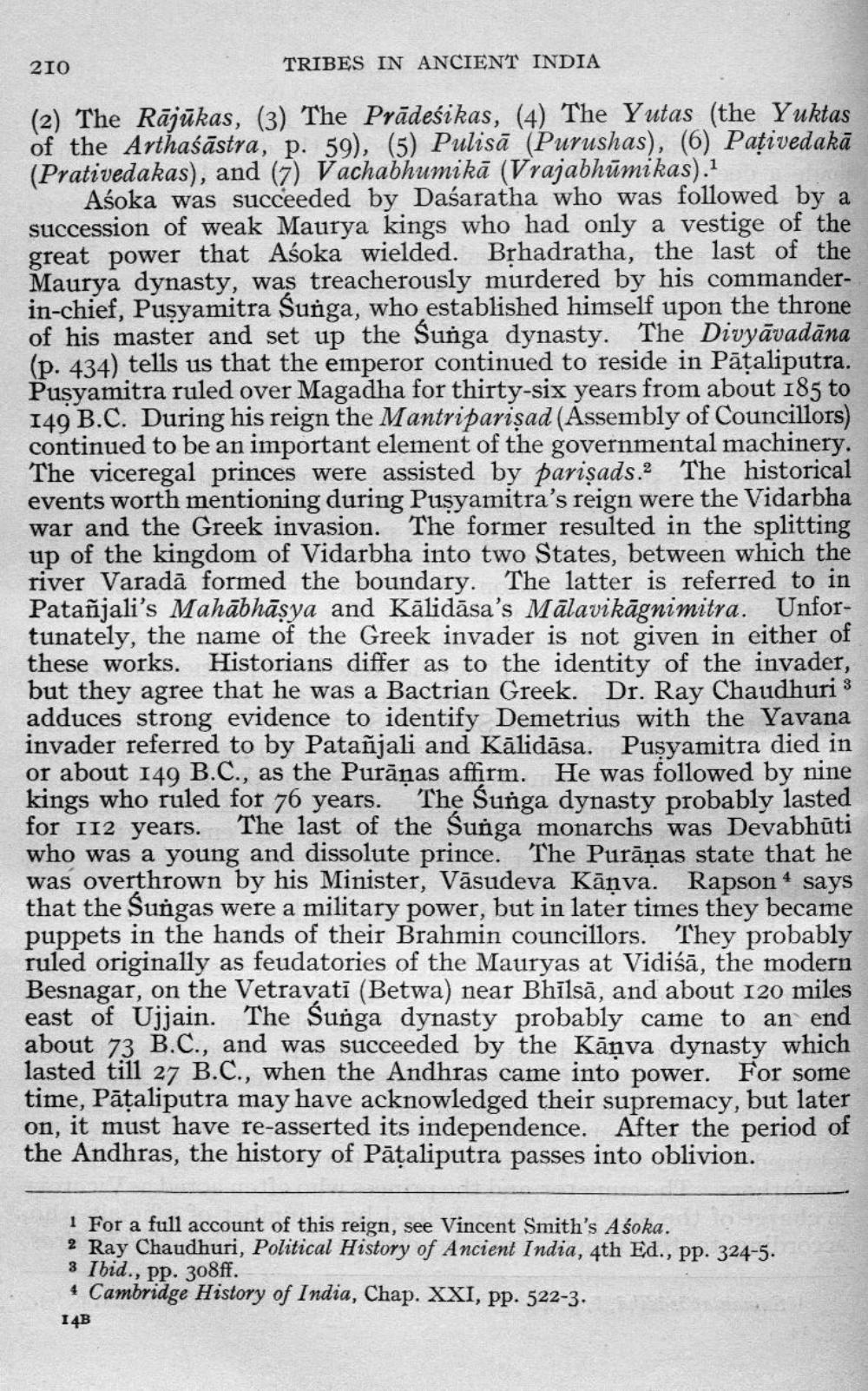________________
TRIBES IN ANCIENT INDIA
(2) The Rajukas, (3) The Pradeśikas, (4) The Yutas (the Yuktas of the Arthasastra, p. 59), (5) Pulisa (Purushas), (6) Pativedakā (Prativedakas), and (7) Vachabhumika (Vrajabhumikas).1
Aśoka was succeeded by Dasaratha who was followed by a succession of weak Maurya kings who had only a vestige of the great power that Aśoka wielded. Brhadratha, the last of the Maurya dynasty, was treacherously murdered by his commanderin-chief, Pusyamitra Sunga, who established himself upon the throne of his master and set up the Sunga dynasty. The Divyavadana (p. 434) tells us that the emperor continued to reside in Pataliputra. Pusyamitra ruled over Magadha for thirty-six years from about 185 to 149 B.C. During his reign the Mantripariṣad (Assembly of Councillors) continued to be an important element of the governmental machinery. The viceregal princes were assisted by pariṣads.2 The historical events worth mentioning during Pusyamitra's reign were the Vidarbha war and the Greek invasion. The former resulted in the splitting up of the kingdom of Vidarbha into two States, between which the river Varada formed the boundary. The latter is referred to in Patanjali's Mahabhāṣya and Kalidasa's Malavikāgnimitra. Unfortunately, the name of the Greek invader is not given in either of these works. Historians differ as to the identity of the invader, but they agree that he was a Bactrian Greek. Dr. Ray Chaudhuri 3 adduces strong evidence to identify Demetrius with the Yavana invader referred to by Patanjali and Kālidāsa. Pusyamitra died in or about 149 B.C., as the Puranas affirm. He was followed by nine kings who ruled for 76 years. The Sunga dynasty probably lasted for 112 years. The last of the Sunga monarchs was Devabhuti who was a young and dissolute prince. The Purānas state that he was overthrown by his Minister, Vasudeva Kāṇva. Rapson says that the Sungas were a military power, but in later times they became puppets in the hands of their Brahmin councillors. They probably ruled originally as feudatories of the Mauryas at Vidiśā, the modern Besnagar, on the Vetravati (Betwa) near Bhilsă, and about 120 miles east of Ujjain. The Sunga dynasty probably came to an end about 73 B.C., and was succeeded by the Kanva dynasty which lasted till 27 B.C., when the Andhras came into power. For some time, Pataliputra may have acknowledged their supremacy, but later on, it must have re-asserted its independence. After the period of the Andhras, the history of Pataliputra passes into oblivion.
4
210
1 For a full account of this reign, see Vincent Smith's Aśoka.
2 Ray Chaudhuri, Political History of Ancient India, 4th Ed., pp. 324-5. 3 Ibid., pp. 308ff.
4 Cambridge History of India, Chap. XXI, pp. 522-3.
14B




